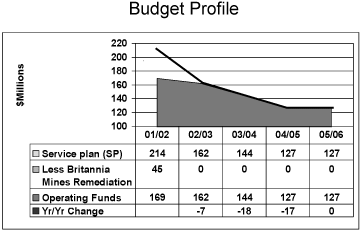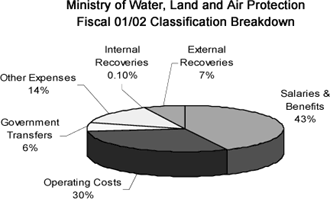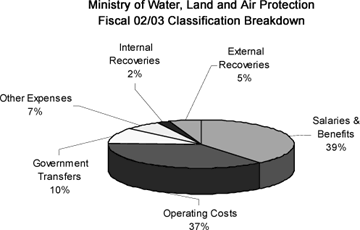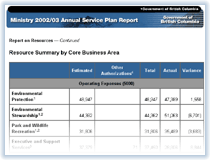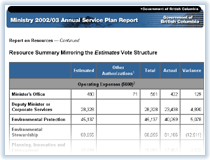 |
|
Report on ResourcesThe ministry is committed to achieving the government's three-year fiscal targets outlined in the 2002/03 – 2004/05 Service Plan. The following sections — "Resource Summary by Core Business Area" and "Resource Summary Mirroring the Estimates Vote Structure" — detail the fiscal performance by the Ministry of Water, Land and Air Protection in 2002/03. The background information below provides an overview of the financial context in which the ministry operates and gives examples showing how financial decisions are aligned with the goals, strategic shifts and performance measurement results outlined in this annual report. BackgroundAs it implements its strategic shifts, the ministry places greater emphasis on:
The ministry places less emphasis on the administration of direct service delivery, or on "doing" functions. It is encouraging and building capacity for others, enabling them to accept a greater role in environmental stewardship and facilitate community initiatives to protect and restore the local environment. This type of structural change will occur over a period of years and depends on a number of factors, such as a sound public policy foundation, regulatory flexibility, an effective transition strategy, and capacity within the community. A key factor that can have a significant impact on how well the ministry is able to implement structural change is capacity. It is influenced by the quality and number of resources available to do this work (e.g., level of employee skills and knowledge, financial resources, and state of technology and systems). The ministry addresses capacity issues by: refining its approach to planning; streamlining operations and processes; reallocating resources between core business areas, as required to meet evolving priorities; developing partnerships to accomplish objectives; and linking employee performance plans and training to goal delivery. Three-Year Fiscal OutlookThe budget profile for the ministry will continue to decrease in 2003/04 and 2004/05 before stabilizing in 2005/06 (see Figure 6). Service Plan funding for 2003/04 onwards includes retaining existing recreation revenue.
Figure 6. Budget profile 2001/02 to 2005/06 In fiscal year 2002/03, the ministry's operating budget was $162.565 million, with actual expenditures of $162.547 million, resulting in a surplus of $0.018 million. Excluding funding for the Britannia Mine remediation, this represents a 4% decrease over the 2001/02 operating budget of $169.266 million. This initial small decrease in operational funding allowed the ministry to fund a number of its important strategic shifts.
Figure 7
Figure 8 Consistent with the strategic shift towards a greater emphasis on planning and checking, the distribution of ministry expenditures by classification is also shifting. The ministry is spending a smaller percentage on salaries and benefits, while increasing operating expenditures and government transfers, signalling a move to an external service delivery model. This trend is expected to continue as the role of the ministry and government changes from a service provider to a manager of the service delivery model.
Overview of Key Expenditure AreasThe following is a brief overview of some key expenditure areas in the 2002/03 fiscal year. Salaries and Benefits Through workforce adjustment over the last two years, the ministry has reduced its budgeted FTE allocation from 1,298 in 2001/02 to 1,138 in 2002/03, for a total reduction of 12%. Actual salaries and benefits costs were reduced by 10%, reflecting a heavier reliance on technical staff to implement the shift to a science-based approach to standards setting. A further workforce adjustment was implemented in October 2002 to bring the budgeted FTE allocation down to 998 for fiscal 2003/04. Operating Costs Some operating costs in 2002/03 demonstrate the ministry's progress in making its strategic shifts. The ministry has increased expenditures for staff training by 56%. Contracting expenditures to enable small business operators in all regions to deliver services have increased by 67%. As well, travel expenditures for regional staff (e.g., Compliance and Conservation Officers) to perform their duties throughout the province have increased by 25%. These increased expenditures reflect the ministry's commitment to provide sufficient operational funding for staff responsible for service delivery and to create economic opportunities through partnerships with small business. Government Transfers The use of government transfers is another key expenditure area that reflects the ministry's effectiveness in delivering a transition strategy while building capacity within the community. Some expenditures in this area include a $2.6 million endowment payment to establish the Freshwater Fisheries Society of B.C. Additional expenditures include payments to:
Continuous Improvement As part of its ongoing commitment to improve the links between revenues and expenditures and Service Plan objectives during 2002/2003, the Corporate Services Division worked with the divisions to redesign the ministry's chart of accounts. Changes as a result of this redesign will allow the ministry to record expenditures by goals and objectives, and to improve its ability to report fiscal performance results to the public. This change will be implemented beginning in the 2003/04 fiscal year. Resource Summary by Core Business Area
Resource Summary Mirroring the Estimates Vote Structure
|
||||||||||||||||||||||||||
|
|||||||||||||||||||||||||||
